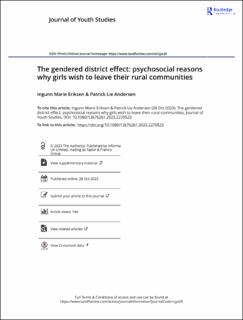| dc.contributor.author | Eriksen, Ingunn Marie | |
| dc.contributor.author | Andersen, Patrick Lie | |
| dc.date.accessioned | 2023-11-13T08:18:09Z | |
| dc.date.available | 2023-11-13T08:18:09Z | |
| dc.date.created | 2023-11-11T19:26:43Z | |
| dc.date.issued | 2023 | |
| dc.identifier.issn | 1367-6261 | |
| dc.identifier.uri | https://hdl.handle.net/11250/3102051 | |
| dc.description.abstract | The rural youth exodus has mostly been explained with the pull of
the city. In this mixed-method study, we explore whether young
people also experience a push to leave the rural community due
to a lack of psychosocial thriving. The quantitative analysis of the
Ungdata-survey among young people aged 13–16 years (n =
141,058) shows that girls imagine leaving more than boys, and
also fare worse on many indicators for psychosocial well-being.
There is a linear decline in girls’ psychosocial well-being the less
centrally they live. We call this the gendered district effect. Contrary
to expectations, we find that rural girls without higher education
aspirations are those who least want to stay in the rural
community. It is likely that a lower degree of psychosocial well-
being is part of the reason that more girls in rural areas wish to
leave their homeplace. The qualitative analysis of the rural village
of Smallville (n = 21) explores this, showing that girls commonly
wanted to leave to escape a toxic social environment, which also
offered few status-filled work opportunities in the village. The girls
were more affected by the rural community’s restricting social
norms, leaving girls with poor self-images and the wish to leave. | en_US |
| dc.language.iso | eng | en_US |
| dc.rights | Navngivelse 4.0 Internasjonal | * |
| dc.rights | Navngivelse 4.0 Internasjonal | * |
| dc.rights.uri | http://creativecommons.org/licenses/by/4.0/deed.no | * |
| dc.title | The gendered district effect: psychosocial reasons why girls wish to leave their rural communities | en_US |
| dc.type | Peer reviewed | en_US |
| dc.type | Journal article | en_US |
| dc.description.version | publishedVersion | en_US |
| cristin.ispublished | true | |
| cristin.fulltext | original | |
| cristin.qualitycode | 2 | |
| dc.identifier.doi | 10.1080/13676261.2023.2270523 | |
| dc.identifier.cristin | 2195354 | |
| dc.source.journal | Journal of Youth Studies | en_US |

